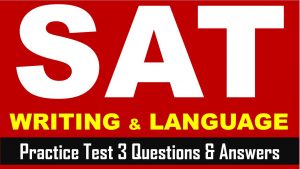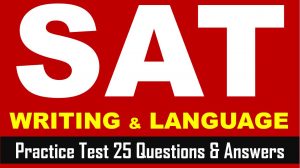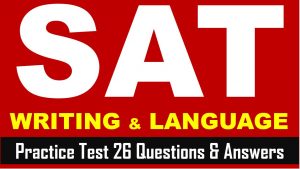Hi SAT Aspirants, welcome to AKVTutorials. As you know SAT (Scholastic Assessment Test) is a standard test, used for taking admission to undergraduate programs of universities or colleges of United States. SAT is developed and published by the College Board, an organization in United States, administered by the Educational Testing Service. Therefore, you need to do practice on SAT Reading Section, SAT Writing and Language Section. In this article, you will get SAT Writing Practice Questions Paper 75 with Answer Keys AMBIPi.
Instruction:
- In the passage below is accompanied by a number of questions.
- For some questions, you need to think how the passage might be revised to improve the expression of ideas.
- For other questions, you will consider how the passage might be edited to correct errors in sentence structure, usage, or punctuation.
- Some questions will direct you to an underlined portion of a passage.
- Other questions will direct you to a location in a passage or ask you to think about the passage as a whole.
SAT Writing & Language Section Passage
SAT Writing Practice Questions Paper Passage Title: The Pumpkin Papers
On the night of December 2, 1948, the pale light of a crescent moon barely illuminated the outlines of two men standing beside a pumpkin patch in Carroll County, Maryland. Nearby, a third man stooped low to the ground, groping around in the pumpkins before grabbing one and 1 pulls off the top. Inside the hollowed interior 2 laid a small package wrapped in wax paper. Within this unassuming package were both developed and undeveloped microfilm images—evidence that produced the final impetus needed for the controversial indictment of suspected Communist spy Alger Hiss.
The story of these eccentrically concealed microfilm images—affectionately, if inaccurately, dubbed the ‘pumpkin papers’ by the 3 press—had begun a decade earlier when Whittaker Chambers, 4 the man who revealed the evidence on that December evening decided to defect from the underground Communist party.
It was not a decision lightly made; as Chambers wrote 5 in retrospect, 5 “two things made that break and that flight possible., Sure that he could no longer serve a force he believed to be evil, Chambers took his family and temporarily 6 fled into hiding. As a precaution, he also preserved material evidence—including the microfilm—that verified both his own involvement and the involvement of other underground agents prior 7 from his defection.
A decade later, this precaution would prove invaluable. In November of 1948, Chambers faced a slander suit from Alger Hiss, one of his former compatriots whom he had reluctantly identified as a communist in a public interview. This comment opened the door for Hiss to make an aggressive legal attack during a period when both men were already embroiled in an investigation by the House Committee on Un-American Activities (HUAC). Although Chambers had deliberately chosen not to reveal the microfilm, this legal attack convinced him to tacitly admit its existence to Robert Stripling, the chief investigator of HUAC. When two investigators traveled to 8 Chambers’ farmhouse the following evening, he led them to the backyard and revealed the evidence hidden inside the hollow pumpkin.
9 Many people still believed that Alger Hiss was innocent: while some sources argue that the actual content of the microfilm had little relevance to the case, others suggest that the 10 sequential public interest created pressure for a careful verdict. However, there is no question that the indictment of Alger Hiss on December 15 represented both a triumph and a tragedy. The conflict between these two men was only a microcosm of the massive, destructive struggle between two incompatible philosophies; perhaps it is best summarized by 11 Richard Nixon as a struggle “dependent upon the question of identity.”
SAT Writing Practice Questions Paper
Question No 1
Which choice best maintains the sentence pattern already established in the paragraph?
Option A : No Change
Option B : pulled
Option C : was pulling
Option D : pulling
Answer
Show/Hide Answer
Option D : pulling
Question No 2
Which of the following options is the most effective?
Option A : No Change
Option B : lying
Option C : lay
Option D : lain
Answer
Show/Hide Answer
Option C : lay
Question No 3
Which choice provides the most effectively transition to the information that follows?
Option A : No Change
Option B : press, had
Option C : press; had
Option D : press had
Answer
Show/Hide Answer
Option A : No Change
Question No 4
At this point, the writer is considering deleting the underlined portion. Should the writer make this deletion?
Option A : Yes, because this phrase contradicts the characterization of Chambers provided in the introduction.
Option B : Yes, because this phrase repeats information about the identity of Chambers already provided in the introduction.
Option C : No, because this phrase helps explain why Chambers decided to defect from the Communist party.
Option D : No, because this phrase identifies one of the unnamed characters in the introduction as Chambers.
Answer
Show/Hide Answer
Option D : No, because this phrase identifies one of the unnamed characters in the introduction as Chambers.
Question No 5
At this point, the writer wants to provide support for the statement made in the first part of the sentence. Which of the following quotations by Chambers best accomplishes this goal?
Option A : No Change
Option B : “in any such change as I was making, the soul itself is in flux.”
Option C : “practicality and precaution are of no more help than prudence or craft.”
Option D : “I committed the characteristic crimes of my century.”
Answer
Show/Hide Answer
Option B : “in any such change as I was making, the soul itself is in flux.”
Question No 6
Which choice best maintains the sentence pattern already established in the paragraph?
Option A : No Change
Option B : hid with his family for a short time.
Option C : went on the run and into hiding after this decision.
Option D : went into hiding with his wife and children.
Answer
Show/Hide Answer
Option A : No Change
Question No 7
Which choice best maintains the sentence pattern already established in the paragraph?
Option A : No Change
Option B : for
Option C : to
Option D : in
Answer
Show/Hide Answer
Option C : to
Question No 8
The writer is considering deleting the underlined sentence. Should the sentence be kept or deleted?
Option A : NO CHANGE
Option B : Chamber’s farmhouse
Option C : Chambers farmhouses’
Option D : the farmhouse of Chamber’s
Answer
Show/Hide Answer
Option A : NO CHANGE
Question No 9
Which choice provides the smoothest transition from the previous paragraph to this one?
Option A : No Change
Option B : Hiding the microfilm inside a pumpkin may not have been wise:
Option C : Opinions on the importance of the pumpkin papers are split:
Option D : Few people paid attention to this aspect of the investigation:
Answer
Show/Hide Answer
Option C : Opinions on the importance of the pumpkin papers are split:
Question No 10
Which choice best maintains the sentence pattern already established in the paragraph?
Option A : No Change
Option B : consequent
Option C : adjacent
Option D : nearby
Answer
Show/Hide Answer
Option C : adjacent
Question No 11
The writer wants to conclude with a strong, memorable reference that captures the broad historical significance of this struggle. Which choice best accomplishes this goal?
Option A : No Change
Option B : Robert Stripling’s comment at one of the many hearings: “you are a remarkable and agile young man, Mr. Hiss.”
Option C : Whittaker Chambers’ own phrase, “a tragedy of history.
Option D : Alger Hiss’s statement that he would do everything in his means “to get at the truth.
Answer
Show/Hide Answer
Option C : Whittaker Chambers’ own phrase, “a tragedy of history.



